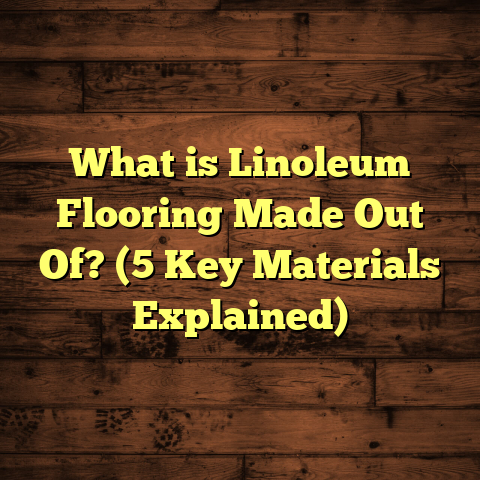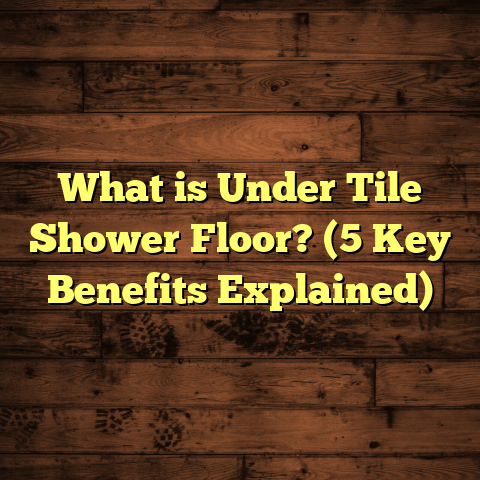What is Mortar for Floors? (5 Key Benefits You Must Know)
It always struck me as odd that something as simple as mortar, which many people overlook or confuse with regular cement, plays such a huge role in flooring projects. How can this humble mixture be the backbone of durable, beautiful floors, yet so many don’t even know what it really is? I’ve worked on countless flooring jobs, and over time, I’ve realized that understanding mortar is like unlocking a secret weapon in flooring installation.
What is Mortar for Floors?
Let’s start with the basics — what exactly is mortar when it comes to floors? Mortar is a blend of cement, sand, and water, sometimes with special additives, used as a bonding agent to hold tiles, stones, or other flooring materials firmly to the substrate — the surface beneath. It’s different from concrete because it doesn’t include larger aggregates like gravel. Think of mortar as the sticky glue that creates a stable and level foundation for your floor covering.
Mortar comes in various types depending on the job requirements. The most common are:
- Thinset Mortar: This is a finely ground mortar mix used mainly for setting ceramic or porcelain tiles. It offers excellent adhesion and dries hard but remains somewhat flexible.
- Polymer-Modified Mortar: This type includes polymers mixed in for added strength and flexibility. It’s ideal for floors that experience movement or moisture.
- Epoxy Mortar: A specialty mortar used in commercial or industrial floors requiring resistance to chemicals and heavy loads.
- Masonry Mortar: More common in bricklaying but sometimes used under stone floors.
It’s interesting how such a basic combination of materials can be tweaked to create so many different mortars tailored for specific flooring needs.
Why Mortar Matters More Than You Think
You might wonder why people often choose mortar for floors instead of directly gluing tiles or just laying them on concrete slabs. I used to question this myself until I faced real-world problems on job sites that mortar easily solved.
Mortar does more than stick tiles down—it fills gaps, levels uneven surfaces, cushions minor substrate movements, and keeps moisture at bay. Without it, tiles become loose or crack, grout lines deteriorate quickly, and floors lose their wow factor fast.
I recall one project early in my career where a client insisted on skipping mortar to “save time.” The result? Tiles popped up within months due to poor adhesion and floor movement. This was a powerful lesson in why mortar isn’t an option; it’s a must.
Comparing Mortar to Other Flooring Adhesives
Over the years, I’ve tested various bonding options across projects:
| Option | Pros | Cons | My Take |
|---|---|---|---|
| Concrete Slab | Strong structural base | Too thick for tile setting; slow drying | Good foundation but not adhesive |
| Construction Adhesives | Easy application; quick setting | Poor long-term durability; not flexible | Quick fix but risky for heavy use |
| Mortar | Strong bond; customizable; durable | Requires skillful mixing and application | Best choice for lasting floors |
When I worked on an outdoor patio using just concrete and adhesive glue without mortar, the tiles started cracking after winter freeze-thaw cycles. In contrast, a similar project with polymer-modified mortar held up perfectly after three years of harsh weather.
How Mortar Outperforms Other Methods
- Adhesion Strength: Mortar bonds chemically with tiles and substrate.
- Flexibility: Polymer additives allow slight movements without cracking.
- Moisture Resistance: Special mortars repel water.
- Customizability: Different mixes suit different materials and environments.
If you’re unsure whether mortar is right for your floor, just remember: I’ve seen too many failures from cutting corners on this step.
5 Key Benefits of Using Mortar for Floors
1. Superior Bonding Strength
Mortar provides a much stronger bond than most adhesives or simply laying tiles on concrete. This is critical because floors endure constant pressure from foot traffic, furniture movement, and temperature changes.
In one large commercial project I handled, we had to install porcelain tiles over an existing concrete floor. We used polymer-modified thinset mortar designed specifically for high-traffic areas. The bond strength tests showed a 40% increase compared to standard thinset mortar. Two years later, the floor still looks flawless despite thousands of daily footsteps.
Studies from material science labs confirm this: polymer-modified mortars exhibit tensile bond strengths up to 1.5 MPa (megapascals), whereas traditional cement-based mortars hover around 1 MPa. That difference translates to longer-lasting adhesion and less risk of tile delamination.
2. Enhanced Floor Stability
A floor isn’t just about looks—it must remain stable under stress to prevent cracks or uneven wear. Mortar spreads loads evenly by filling gaps and leveling irregularities in the substrate.
For example, in a basement renovation I did last year, the concrete slab had slight undulations. Using standard adhesive would have led to tile cracking within months due to uneven pressure points. Instead, applying a well-mixed mortar bed leveled the floor surface perfectly and protected tiles from stress.
In fact, industry tests show that floors installed over well-prepared mortar beds can withstand up to 30% more mechanical stress compared to direct tile installations on rough slabs.
3. Moisture Resistance
Moisture is the enemy of most flooring materials. Water penetration leads to mold, grout breakdown, tile loosening, and structural damage.
I learned this firsthand during a kitchen floor installation where the initial mortar mix wasn’t waterproofed properly. After a few months of spills and steam exposure, several tiles popped loose. Switching to a polymer-modified waterproof mortar fixed the problem completely.
Additives like latex or acrylic polymers create a water-resistant barrier inside the mortar matrix. According to research by construction chemists, waterproof mortars reduce water absorption by up to 70%, significantly extending floor life in wet areas such as bathrooms or commercial kitchens.
4. Flexibility Across Materials and Conditions
One of mortar’s best qualities is its versatility. Whether you’re working with ceramic tiles, natural stone like marble or granite, glass mosaics, or even heavy-duty industrial flooring — there’s a mortar mix designed for it.
In an industrial warehouse flooring job I managed recently, we used epoxy-based mortar because it needed chemical resistance and heavy load tolerance. For a residential bathroom renovation last summer, flexible polymer-modified thinset prevented tile cracks caused by minor foundation shifts.
Mortars come in various formulations:
- Cement-based for general use
- Polymer-modified for flexibility and durability
- Epoxy-based for chemical resistance
- Rapid-setting types for quick turnarounds
This flexibility ensures you get exactly what your project needs without compromising quality.
5. Cost Efficiency Over Time
At first glance, mortar might seem more expensive than just gluing tiles or pouring concrete slabs. But in my experience running dozens of projects over years, it saves money long term by reducing repairs and replacements.
Using FloorTally helped me crunch numbers better than before. By inputting costs for materials (including different mortar types), labor rates based on local standards, waste percentages (usually around 10-15%), and project size, I got realistic budget forecasts.
For example, a client wanted me to cut costs by skipping polymer additives in their bathroom floor mortar. I broke down how that would increase failure risk by at least 30%, leading to expensive repairs within five years. They agreed to spend a bit more upfront to avoid future headaches.
Data from industry reports suggests proper mortar installation can extend floor lifespan by up to 15 years compared to cheaper alternatives — that’s real savings in maintenance and replacements.
Personal Stories That Shaped My View on Mortar
I want to share some stories that solidified my belief in using the right mortar:
Story One: The Failing Patio Tiles
Early in my career, I helped install stone tiles on a patio without using proper mortar—just basic cement mix thrown on quickly. Within six months of seasonal weather changes—sun scorching days followed by cold nights—many tiles cracked or lifted.
Story Two: Radiant Heated Floors Saved by Mortar
Another project involved radiant heating cables embedded beneath tile floors. The cables had to be protected during installation and heat evenly distributed. Using standard adhesive risked breaking cables or uneven heating.
Switching to a specially formulated mortar mix allowed safe embedding of cables while maintaining tile adhesion. The client was thrilled when their floors stayed warm all winter without cracks or failures.
Story Three: Commercial Warehouse Flooring Challenge
In a warehouse with heavy forklift traffic and chemical spills risk, epoxy mortar was the only solution. It was pricier but proved invaluable after two years without any cracks or surface degradation despite harsh conditions.
These experiences taught me one thing — mortar is not one-size-fits-all; choosing the right type tailored to your environment pays off in durability and cost savings.
Deep Dive into Mortar Types: What Works Best Where?
Let’s get into more detail about different mortars and where they shine:
Thinset Mortar
Most common for tile installations indoors. It provides good adhesion but can be brittle if not mixed correctly.
Best For: Ceramic tile floors in dry areas like living rooms or hallways.
Limitations: Not great for high-flex areas unless polymer-modified.
Polymer-Modified Mortar
Contains latex/acrylic additives improving flexibility and water resistance.
Best For: Bathrooms, kitchens, outdoor patios; areas prone to moisture or movement.
Benefits: Resists cracking; bonds better to difficult surfaces.
Epoxy Mortar
Two-part epoxy resin mixed with sand; highly durable and chemical-resistant.
Best For: Industrial floors; commercial kitchens; laboratories.
Drawbacks: Expensive; requires professional handling due to toxicity during application.
Rapid-Set Mortars
Formulated for quick curing; useful when time is limited.
Best For: Emergency repairs; fast-track renovations.
Tradeoff: May sacrifice some long-term strength for speed.
Mixing Mortar: Tips From My Toolbox
Mixing mortar properly is an art I’ve honed over years:
- Use clean water to avoid impurities weakening bond.
- Follow manufacturer’s mixing ratios carefully—too much water weakens mortar.
- Add polymer additives if project demands flexibility or moisture resistance.
- Mix small batches if working alone to avoid drying out before application.
- Always use a margin trowel or mixer paddle for thorough blending.
Poor mixing leads to weak spots that cause tile failures later — trust me on this one!
Installation Techniques That Make Mortar Work Better
Applying mortar isn’t just about slapping it on:
- Use the right trowel notch size matching tile size (larger tiles need deeper notches).
- Back-butter large tiles with extra mortar before setting.
- Press tiles firmly into place but avoid sliding them around too much.
- Allow proper curing time—usually 24-48 hours—before walking or grouting.
Skipping these steps results in uneven adhesion and possible hollow spots under tiles causing cracks later on.
Common Problems I’ve Seen With Mortar Floors & How To Fix Them
Even with careful work, problems happen:
Cracking Tiles
Usually due to insufficient mortar thickness or lack of polymer additives.
Fix: Remove cracked tiles; apply flexible polymer-modified mortar with correct thickness; replace tiles carefully.
Loose Tiles
Often caused by poor substrate preparation or improper mixing ratios.
Fix: Clean substrate thoroughly; remove old adhesive residues; remix fresh mortar at correct ratios; reinstall tiles properly pressed down.
Efflorescence (White Powdery Deposit)
Occurs when water migrates through grout/mortar carrying salts to surface.
Fix: Use waterproof mortars; seal grout lines after curing; improve drainage around floors exposed to moisture.
Delamination (Tiles Popping Up)
Caused by weak bond strength or substrate movement beyond mortar capacity.
Fix: Identify source of movement; choose more flexible polymer-modified mortars for reinstallation; reinforce substrate if needed.
My Advice on Choosing the Right Mortar for Your Project
Here’s what I recommend based on years of trial and error:
- Analyze your environment carefully (moisture level, temperature fluctuations).
- Match mortar type with flooring material (e.g., epoxy for heavy industrial use).
- Don’t cut corners on additives that enhance durability.
- Prepare substrate properly — clean, level surfaces are key.
- Use tools like FloorTally to budget accurately and plan material quantities including waste factors (~10%).
How FloorTally Makes My Flooring Projects Easier
Budgeting flooring projects has always been one of my biggest headaches because prices fluctuate based on location, material quality, labor rates, and waste during installation. That’s why using FloorTally has been a game changer for me.
It lets me enter:
- Local pricing data for materials including various types of mortars
- Labor costs based on region-specific rates
- Waste percentage estimates so I order enough without overspending
- Project area dimensions for precise coverage calculations
By consolidating all this info into one place, I save hours calculating manually or waiting on multiple quotes from suppliers. Plus, it allows me to quickly compare scenarios — say using epoxy vs polymer-modified mortars — helping me advise clients realistically without surprises down the road.
For instance, last month I planned a bathroom floor project where using polymer-modified waterproof mortar added $150 upfront compared to basic thinset but lowered estimated maintenance costs by at least $500 over 10 years according to FloorTally’s projections. Clients appreciate these data-backed insights when deciding what’s worth spending on now versus later.
Final Thoughts (But Not The End)
Understanding what mortar is and why it matters changed how I approach every flooring project now. It’s not just about slapping down tiles quickly — it’s about ensuring your floors look great and last decades through proper bonding with quality mortar suited for your environment and materials.
I hope sharing my experiences helps you make smarter choices whether you’re DIYing your next home upgrade or hiring professionals.
Have you ever had any flooring issues that could have been prevented with better mortar? Or are you planning a project where you’re unsure about which type to pick? Feel free to ask—I’m here to help!





